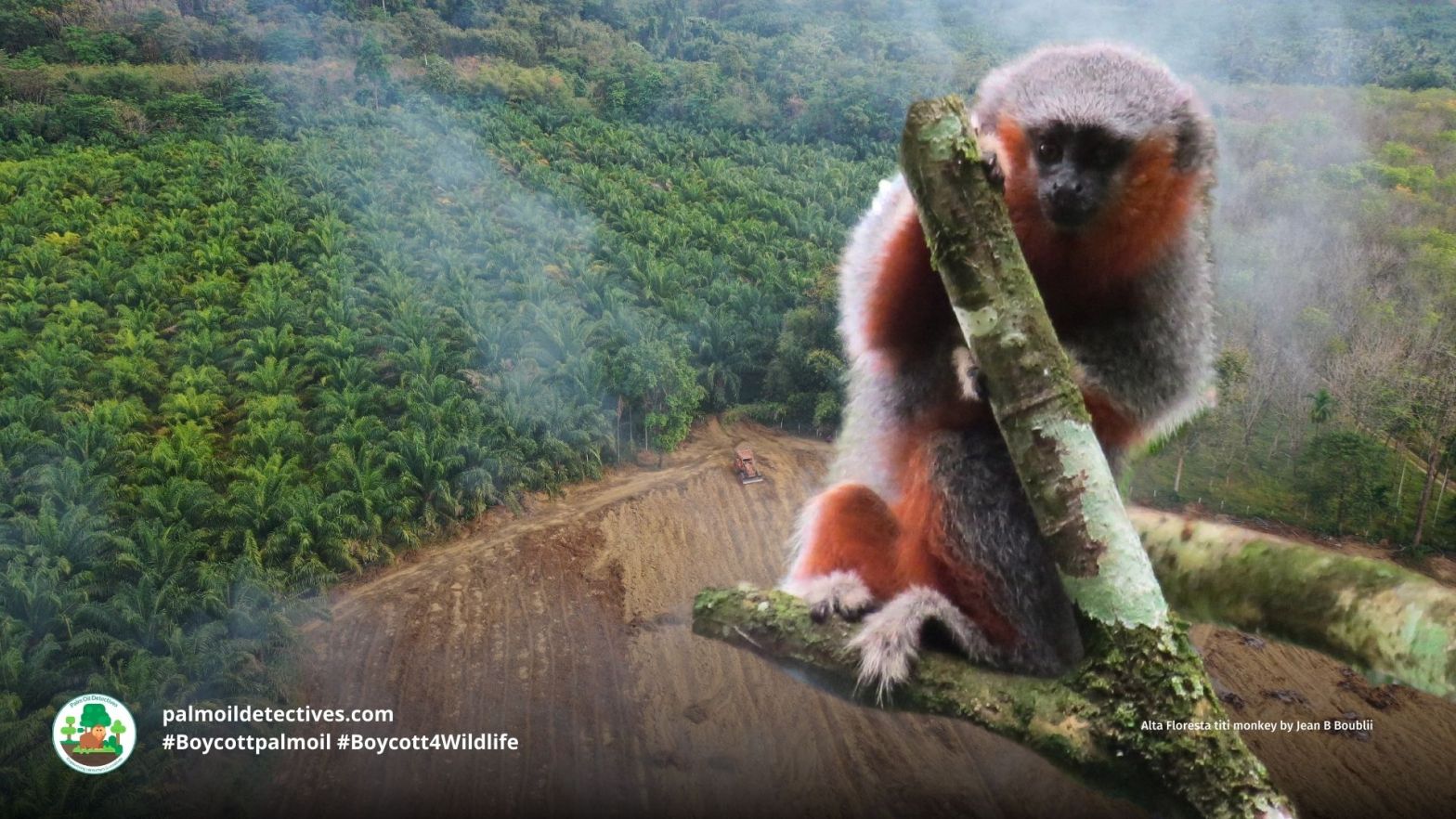Alta Floresta titi monkey (Groves’ Titi) Plecturocebus grovesi
Critically Endangered
Extant (resident)
Brazil (Mato Grosso)
The enchanting Groves Titi Monkey, also referred to as the Alta Floresta titi monkey or Mato Grosso titi monkey made a remarkable entry into the spotlight only recently in 2016 when they were classified by scientists. They belong to the Eastern Amazonian clade of the red-bellied titi monkey (P. moloch) group and are known for their vividly coloured fur and rowdy rainforest vocalisations. They face multiple anthropogenic threats including hunting gold mining, palm oil, meat and soy deforestation and hydroelectric dams. Help them to survive each time you shop, be #vegan and #Boycottpalmoil #Boycott4Wildlife
Take action by sharing this story to Twitter
Discovered only in the past decade, Alta Floresta titi #monkeys 🐒 are critically endangered from #hunting #palmoil and #meat 🥩 #deforestation 🔥 in Brazil 🇧🇷 Help them survive and be #vegan 🥦 🍆 and #Boycottpalmoil #Boycott4Wildlife @palmoildetect https://wp.me/pcFhgU-53T
Alta Floresta titi monkeys are bright coloured #monkeys of #Brazil fighting for survival against widespread #palmoil #soy #meat #deforestation Help them to survive and use your wallet as a weapon, be #vegan #Boycottpalmoil #Boycott4Wildlife @palmoildetect https://wp.me/pcFhgU-53T
This species was initially discovered by a multi-univerity research team in 2016. They immediately classified the Alta Floresta Titi Monkey as being critically endangered with a predicted loss of 86% of their habitat range within the next 24 years. Read paper.
This poignant report highlights the urgent need for conservation efforts to protect this unique primate species. Alongside three other Brazilian species, Alta Floresta Titi Monkey faces imminent extinction, an urgent situation that warrants immediate attention.
Species of Titi Monkey – illustration by Stephen Nash

Appearance & Behaviour
Alta Floresta Titi Monkeys are members of the red-bellied titi monkey group in the Eastern Amazonian clade. They share a close relationship with the red-bellied titi and Vieira’s titi monkey
Weighing approximately 900 grams (two pounds), these critically endangered primates live in the Brazilian Amazon and are renowned for their harmonious duets with fellow titi monkeys.
What distinguishes them is their speckled or salt and pepper fur on their backs, a red-brown mane and chest, a black tail with a white tip, and light yellow fur on their cheeks. These distinctive characteristics make them an interesting species to observe and appreciate and they obviously need our full respect and protection.

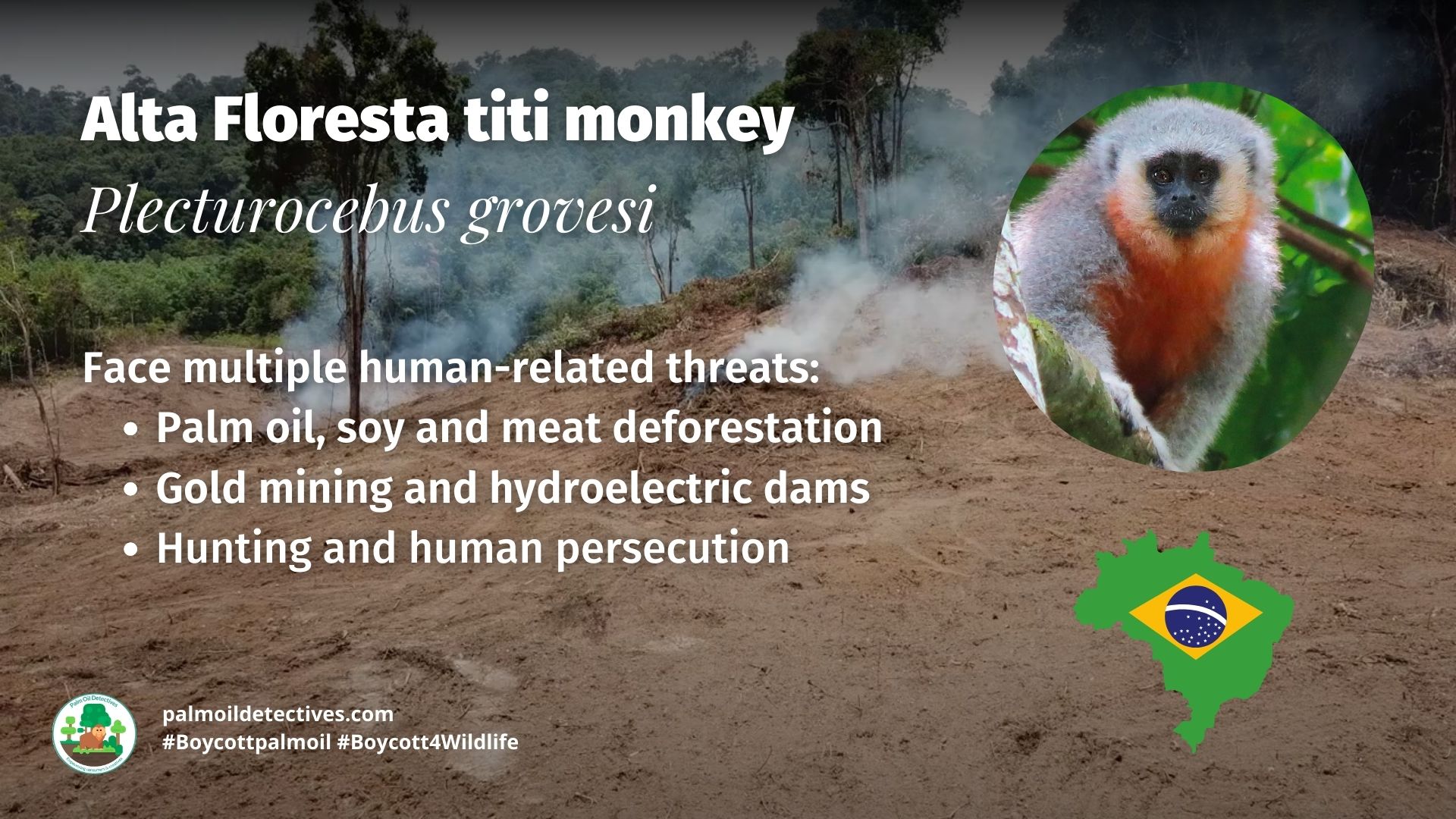
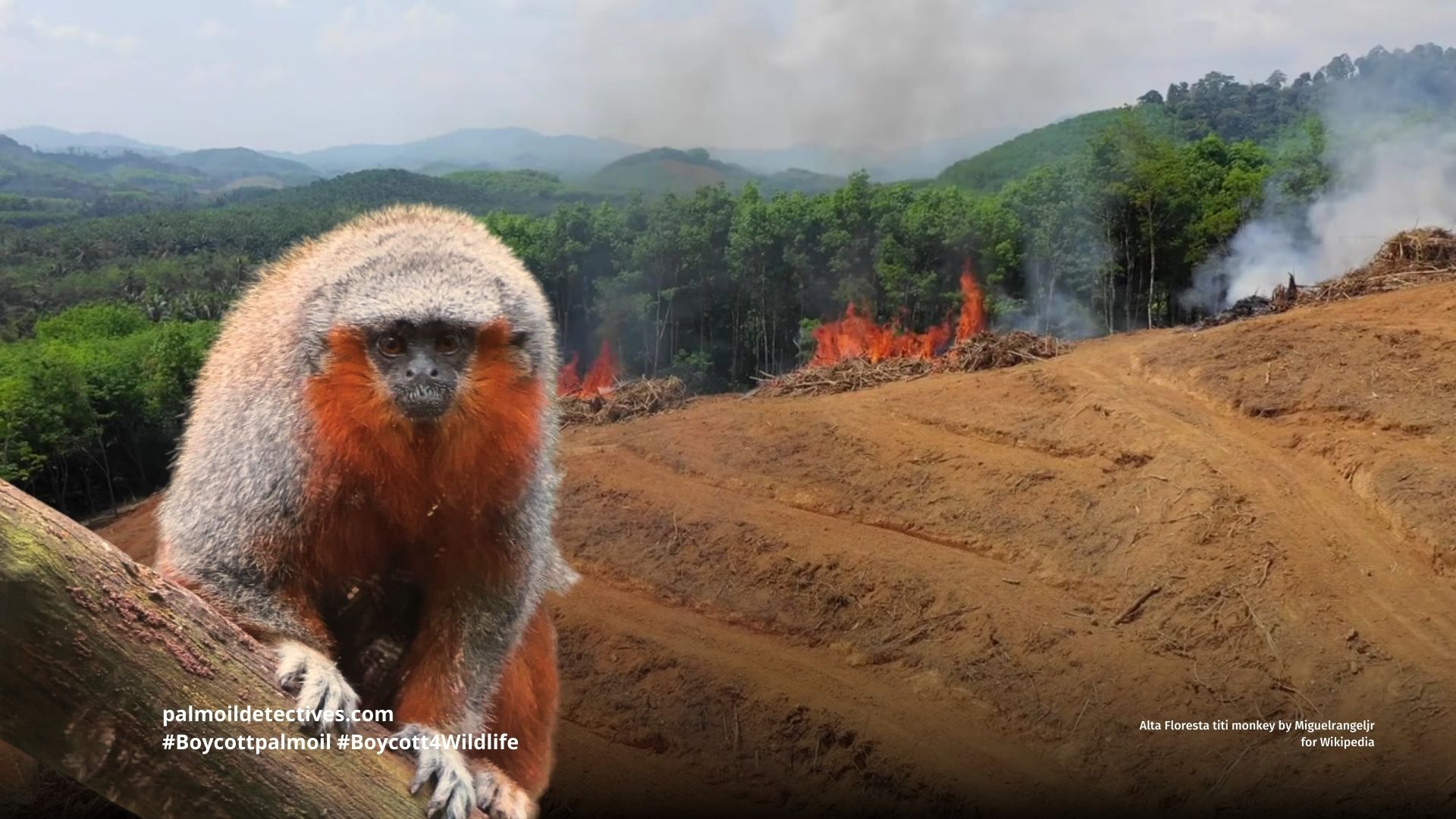

Threats
It is an immense tragedy that a business as usual scenario of rainforest loss will see 86% of their range destroyed over the coming two decades. Their main threats are:
- Habitat degradation and loss: for palm oil, soy and meat deforestation have led to a decline in populations.
- Ongoing Protected Area downgrading: downsizing, and degazettement (PADDD) in the Brazilian Amazon poses a threat.
- A series of hydroelectric dams and mines: in the region further endangers the species.
- Hunting and human persecution: This species is hunted for food.
Boubli et al. (2019) estimated a loss of 42% of habitat (forest, excluding savannas) within the species range to date, or 39% of the species’ total range (forest and savannas). Using predictive models, the species’ habitat loss over the next 24 years will amount to 50% under the “governance” scenario and to 86% under the “business as usual” scenario (Boubli et al. 2019).
IUCN red list
Due to the ongoing process of Protected Area downgrading, downsizing, and degazettement (PADDD) in the Brazilian Amazon and the planned hydroelectric complex of dams for this region (Bernard et al. 2014, Fernandes et al. 2017, Ferreira et al. 2014, Pack et al. 2016, UHE Teles-Pires 2018), the “business as usual” scenario is considered more probable.
Based on this, we classify Plecturocebus grovesi as Critically Endangered (CR A3c), i.e., population reduction projected, inferred or suspected to be met in the future [up to three titi monkey generations, i.e., 24 years (Veiga et al. 2011, Defler and García 2012)], considering a decline of greater than 80% in extent of occurrence (EOO) and/or habitat quality.
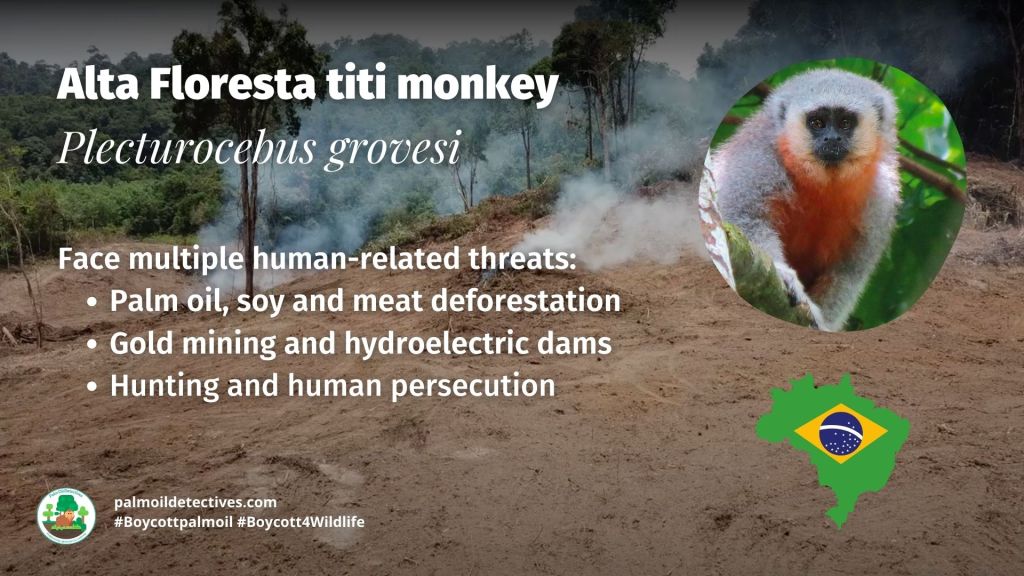
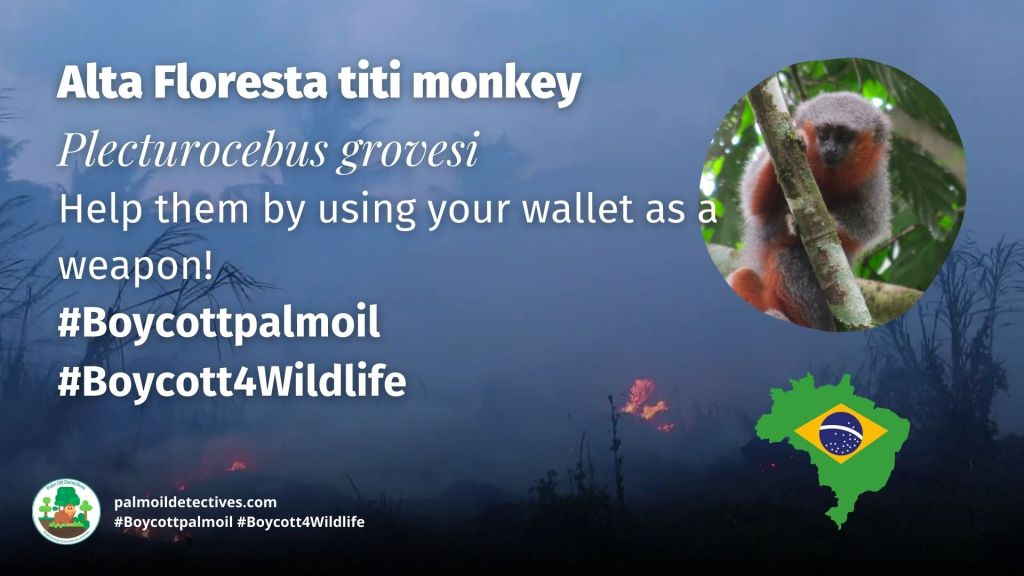
Habitat
Alta Floresta titi monkeys are only found in a small pocket of land (relative to the enormous size of Brazil), the Mato Grosso state of Brazil.
Their habitat is defined by the rivers Juruena and Arinos to the west and the Rio Teles-Pires to the east. The southernmost record of their presence is approximately at 10 degrees south latitude.
It is likely that their range is limited by the transition from the Amazon forest to the Cerrado ecosystem, estimated to be around 13 degrees south. However, further studies are needed to confirm this assumption. Previously, this area was believed to be inhabited by Plecturocebus moloch, another monkey species.
Diet
Plecturocebus grovesi have a diverse diet including a variety of foods such as fruits, leaves, flowers, and insects. They enjoy ripe and juicy fruits found in their habitat, along with tender leaves and delicate flowers. Insects also make up a part of their diet, providing them with a valuable source of protein.
Support the Alta Floresta titi monkey by going vegan and boycotting palm oil in the supermarket, it’s the #Boycott4Wildlife
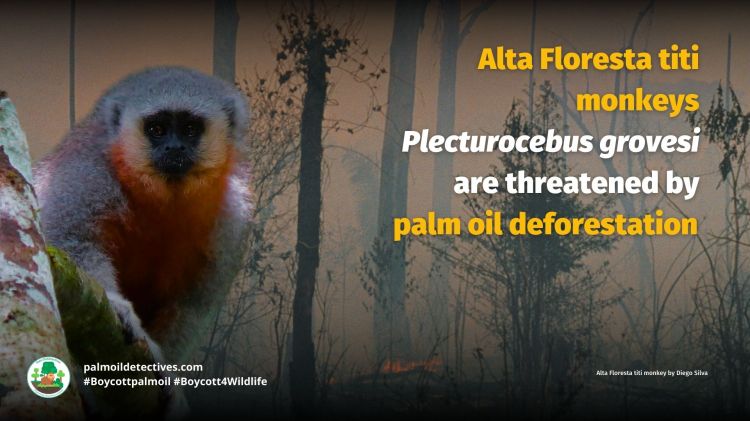
Support the conservation of this species
This animal has no protections in place. Read about other forgotten species here. Create art to support this forgotten animal or raise awareness about them by sharing this post and using the #Boycottpalmoil #Boycott4Wildlife hashtags on social media. Also you can boycott palm oil in the supermarket.
Further Information
Boubli, J., de Melo, F.R. & Rylands, A.B. 2020. Plecturocebus grovesi. The IUCN Red List of Threatened Species 2020: e.T172272064A172272430. https://dx.doi.org/10.2305/IUCN.UK.2020-3.RLTS.T172272064A172272430.en. Accessed on 31 October 2022.
BOUBLI, J. P. et al. On a new species of titi monkey (Primates: Plecturocebus, Byrne et al., 2016), from Alta Floresta, southern Amazon, Brazil. Molecular Phylogenetics and Evolution. Vol. 32, pp. 117–37. March 2019.
Alta Floresta titi monkey Plecturocebus grovesi: Wikipedia
Alta Floresta titi monkey Plecturocebus grovesi: Animalia.bio
IFL Science: Want to hear some Titi monkeys sing duets? their songs may soon be lost to extinction

How can I help the #Boycott4Wildlife?
Contribute in five ways
1. Join the #Boycott4Wildlife on social media and subscribe to stay in the loop: Share posts from this website to your own network on Twitter, Mastadon, Instagram, Facebook and Youtube using the hashtags #Boycottpalmoil #Boycott4Wildlife.
2. Contribute stories: Academics, conservationists, scientists, indigenous rights advocates and animal rights advocates working to expose the corruption of the palm oil industry or to save animals can contribute stories to the website.
3. Supermarket sleuthing: Next time you’re in the supermarket, take photos of products containing palm oil. Share these to social media along with the hashtags to call out the greenwashing and ecocide of the brands who use palm oil. You can also take photos of palm oil free products and congratulate brands when they go palm oil free.
4. Take to the streets: Get in touch with Palm Oil Detectives to find out more.
5. Donate: Make a one-off or monthly donation to Palm Oil Detectives as a way of saying thank you and to help pay for ongoing running costs of the website and social media campaigns. Donate here

